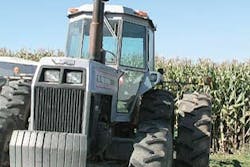Twelve months ago, the North American farm tire market was buoyed by robust export demand, high commodity prices and other forces. Those factors are still in play – though perhaps not as strongly – as 2009 winds down.
In this exclusive online article, executives from the country's leading farm tire manufacturers and marketers discuss the present state of the North American farm tire market. Participants include:
* Ken Allen, president, agricultural tire, U.S. and Canada, Commercial Tire Sales, Bridgestone Americas Tire Operations LLC.
* Bill Dashiell, vice president of product marketing, TBC Wholesale.
* Bill Haney, sales director, Balkrishna Industries Ltd. (BKT-Tyres).
* Jeff Jankowski, director of sales, North America, Trelleborg Wheel Systems.
* Eric Sweigart, vice president of marketing and sales, Michelin North America Inc.
* James Tuschner, marketing director, Alliance Tire USA.
* Jeff Vasichek, vice president of sales and marketing, Titan International Inc.
Here’s what they had to say when www.moderntiredealer.com asked: "The farm tire market in 2008 was extremely robust. What have conditions been like this year?"
Allen: The sector of ag whose primary income is related to the production of grain is still quite robust. It is at or near 2008 levels. However, the sectors related to milk production and non-primary farm applications such as landscaping and large acreage owners are victims of the general poor conditions of the economy.
Dashiell: Frankly, we struggled a little in the later part of last year and the beginning of 2009 as we completed the resourcing of some of our farm tire products. For the year, farm tire unit sales have been good as a result of these new product lines.
Haney: The farm economy overall has been what I would describe as typical – some good, some bad. The farming goes on, fortunately. Farmers are much more careful with their spending this year.
Jankowski: In 2009, our business was very good January through July. Our supply on all products was excellent and our dealers were purchasing products for the spring planting season. In August, the market started to slow down. Some of it was seasonal. We felt it the most on the OE side. However, it did pick up in September on the replacement side because fall harvesting had started in the U.S. Our order books for November and December look really good.
Sweigart: The inertia of 2008 carried through into 2009 as deliveries of new machines continued their record pace, especially large tractors and combines. Crop commodity prices continued their decline from unprecedented highs, which instilled a more conservative mood across the market. The U.S. ag market is quite cyclical and the downturn of the second half of 2009 is merely a reflection of the economic turbulence that we see across the globe in all sectors.
Tuschner: There was such a great contrast between 2009 and 2008. Last year, OE business was so good and commodity prices were very high. In fact, there was so much OE demand for tires it created, in many cases, extreme shortages for dealers. This year, we’re not seeing shortages, except occasionally for some technical tires or unusual sizes. Commodity prices in 2009 also have settled down relative to 2008.
Vasichek: Farm tires at both OE and the aftermarket had a very strong first half. OE has softened since July due to the OEMs’ annual shutdowns. The demand for export units has dropped due to the current economic conditions, mainly the tightening of finance. Aftermarket sales have been on par with previous years. Farmers still have good balance sheets and even though grain prices are down from last year’s historic highs, they are still favorable, and the farmer’s input costs (fuel, fertilizer, etc.) have dropped.
For more from these farm tire executives – including their thoughts on the impact of the global recession on the North American farm tire market, plus what 2010 will bring – see the December 2009 issue of Modern Tire Dealer, available soon.



